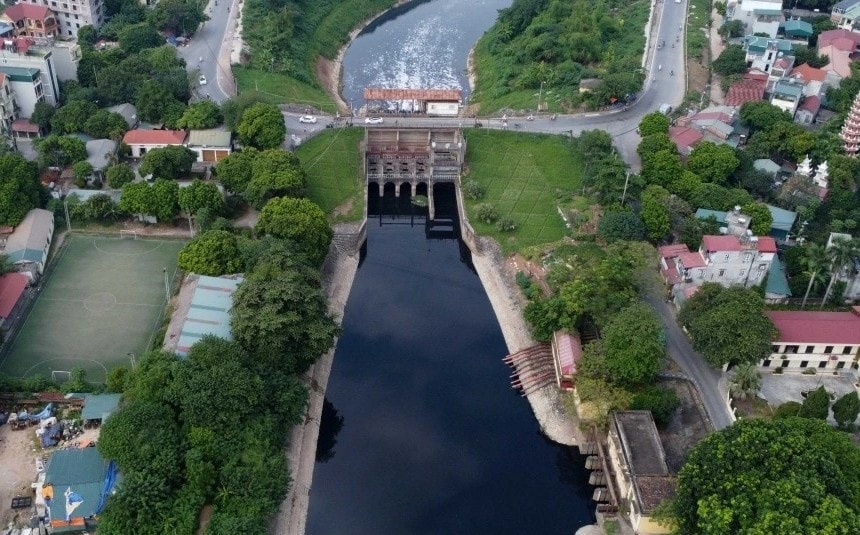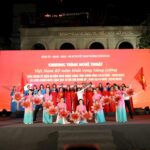Hanoi People’s Committee has just issued Decision No. 4377/QD-UBND approving the investment project for the construction of the rainwater drainage system in the Left Nhue River basin (Phase I).
The project is managed by the Hanoi Project Management Board for Technical Infrastructure and Agricultural Construction as the investor. The construction site is located in the wards and communes of: Dong Ngac, Tu Liem, Dai Mo, Ha Dong, Thanh Liet, Kien Hung, Dai Thanh.
The project is classified as Group B, technical infrastructure, level I; the designed service life of the main structures is approximately 50 years.
The project’s objectives are to concretize the general construction plan for the Capital Hanoi up to 2030 with a vision to 2050, the drainage plan for the Capital Hanoi up to 2030 with a vision to 2050, and the approved S3, S4, GS urban subdivision plans at a 1/2000 scale; to complete the drainage infrastructure system according to the approved plan, increase connectivity between drainage basins for integration, and gradually resolve flooding issues; to improve the living environment for residents in the mentioned wards in particular and the general environment of the city.
The investment scale includes: Construction of drainage channels and culverts; construction of pumping stations; construction of Co Nhue Lake 2 with an area of approximately 7.2 hectares. The implementation period for these project components is from 2024 to 2027, funded by the city budget.
The Hanoi People’s Committee assigns the project investor to be legally responsible for the accuracy of the quantities and costs; the results of structural calculations and the legality of the submitted approval documents; the capacity of organizations and individuals conducting surveys and preparing the project.
Additionally, they are responsible for researching and reviewing the technical infrastructure system in the area, updating the technical infrastructure integration plan to ensure savings, efficiency, and economic-technical optimization; ensuring the operational compatibility between technical infrastructure inside and outside the project; implementing monitoring reports, investment evaluations, and coordinating community monitoring as per current regulations…
Left Nhue River
The Left Nhue River is a significant tributary of the Red River, flowing through the Hanoi Capital Region of northern Vietnam. Historically, it has been vital for local agriculture, transportation, and daily life, shaping the development of the communities along its banks. Today, it remains an important water source but faces challenges related to pollution and urban development.
Dong Ngac
Dong Ngac is a centuries-old Vietnamese village located in northern Hanoi, renowned for its well-preserved ancient architecture and rich cultural heritage. Historically, it was known as a “village of doctors” for producing many esteemed scholars and mandarins during the feudal eras. Today, it offers a glimpse into traditional Vietnamese village life with its old houses, communal houses, and narrow alleyways.
Tu Liem
I am unable to provide a summary for “Tu Liem” as it appears to refer to a modern administrative district of Hanoi, Vietnam, rather than a specific historical place or cultural site with a widely documented history for tourists. For accurate information, it would be best to consult a local resource or a guide focused on Hanoi’s contemporary districts.
Dai Mo
I am unable to identify a specific place or cultural site named “Dai Mo.” It is possible the name is misspelled, refers to a very local or obscure location, or is known by a more common name. Could you please provide any additional context or check the spelling?
Ha Dong
Ha Dong is a suburban district of Hanoi, Vietnam, historically known as a major center for silk production and weaving. Its name, which translates to “East of the River,” reflects its geographic location relative to the old capital. For centuries, it has been renowned for its high-quality silk and traditional craft villages.
Thanh Liet
I am unable to provide a summary for “Thanh Liet” as it does not refer to a widely recognized cultural site, historical landmark, or specific place with documented significance. It is most commonly a place name for communes in Vietnam, such as in Hanoi or Thanh Hoa province, but these are administrative areas rather than tourist or historical destinations.
Kien Hung
I am unable to provide a summary for “Kien Hung” as I do not have sufficient information about this specific place or cultural site in my knowledge base. It is possible this refers to a local or lesser-known location. To get an accurate summary, please verify the spelling or provide more context about its location.
Dai Thanh
I am unable to identify a specific cultural or historical site named “Dai Thanh.” This could refer to a local place name, a temple, or a historical site in Vietnam, but without more specific context, it is not widely recognized as a major landmark. To provide an accurate summary, please provide additional details, such as its location or what type of site it is.






